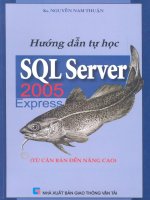Học SQL từ Cơ bản đến Nâng Cao
Bạn đang xem bản rút gọn của tài liệu. Xem và tải ngay bản đầy đủ của tài liệu tại đây (29.2 MB, 45 trang )
A.
Day 1 ws
Introduction to SQL and Relational
Databases
e Understand what SQL is and Its role in managing databases.
e Learn about relational databases and their components.
e Study basic SQL commands: SELECT, INSERT, UPDATE, DELETE.
e Practice writing simple queries and retrieving data from a database.
= Example:
Write a SQL query to retrieve all the columns from the "customers"
table.
? Practice Questions:
1. Write a SQL query to insert a new record into the "employees"
table.
2. Write a SQL query to update the "quantity" column of the
"oroducts" table to 10 where the "product_iad" ts 5.
5. Write a SQL query to delete all records from the "orders" table
where the "status" is 'cancelled'.
nl DATASET:
Click Here -& to View Dataset in Excel Sheet
Day 2 ws
Filtering and Sorting Data
e Learn about the WHERE clause and its usage for filtering data.
e Study the ORDER BY clause for sorting data.
e Practice writing queries with filtering and sorting.
= Example:
Write a SQL query to retrieve all the columns from the "employees"
table where the "salary" is greater than 50000.
? Practice Questions:
1. Write a SQL query to retrieve all the columns from the "products"
table where the "category" is 'Electronics' and the "price" is less than
1000.
2. Write a SQL query to retrieve the names of all customers from the
"customers" table in alphabetical order.
3. Write a SQL query to retrieve the total number of orders from the
"orders" table.
nl DATASET:
Click Here -& to View Dataset in Excel Sheet
Day 35
Joining Tables RIGHT
e Understand the concept of joining tables.
e Learn about different types of joins: INNER JOIN, LEFT JOIN,
JOIN, and FULL JOIN.
e Practice writing queries that involve joining multiple tables.
= Example: name and order date from
them on the "customer_id"
Write a SQL query to retrieve the customer
the "customers" and "orders" tables, joining
column.
? Practice Questions:
1. Write a SQL query to retrieve the product name, category, and
supplier name from the "products", "categories", and "suppliers"
tables, joining them on the appropriate columns.
2. Write a SQL query to retrieve the employee name and department
name from the "employees" and "departments" tables, joining them
on the "department_id" column.
5. Write a SQL query to retrieve the customer name and order amount
from the "customers" and "orders" tables, joining them on the
"customer_id" column, and only including orders with amounts
greater than 1000.
hl DATASET:
Click Here -& to View Dataset in Excel Sheet
Day 4
Aggregating Data
e Study aggregate functions like COUNT, SUM, AVG, MAX, and MIN.
e Learn to use the GROUP BY clause to group data.
e Practice writing queries that involve aggregating data.
= Example:
Write a SQL query to retrieve the total number of orders for each
customer from the "orders" table.
? Practice Questions:
1. Write a SQL query to retrieve the average price of products in each
category from the "products" table.
2. Write a SQL query to retrieve the maximum salary for each
department from the "employees" table.
5. Write a SQL query to retrieve the total revenue generated by each
customer from the "orders" and "order_items" tables.
nl DATASET:
Click Here -& to View Dataset in Excel Sheet
Day 5
Data Manipulation
e Study advanced SQL commands: UPDATE, DELETE, and INSERT INTO
SELECT.
e Understand how to modify existing data in a database.
e Practice writing queries for data manipulation.
= Example: "products"
Write a SQL query to update the "quantity" column of the
table to 20 for all products with a price greater than 100.
? Practice Questions:
1. Write a SQL query to delete all records from the "customers" table
where the "last_login_date" is older than 1 year.
2. Write a SQL query to insert new records into the "employees" table,
selecting data from the "temp_employees" table.
3. Write a SQL query to update the "discount" column of the "orders"
table by increasing it by 5% for all orders placed before a specific
date.
nl DATASET:
Click Here -& to View Dataset in Excel Sheet
A.
Day 6 ws
Advanced Filtering and Sorting
e Learn about advanced filtering techniques: LIKE, IN, BETWEEN, and
NULL.
e Study complex sorting options using multiple columns.
e Practice writing queries with advanced filtering and sorting.
= Example: customers whose names start with
Write a SQL query to retrieve all the
'J' and have a city containing 'York'.
? Practice Questions:
1. Write a SQL query to retrieve all the products with a price either
above 1000 or below 500.
2. Write a SQL query to retrieve the employees who were hired
between a specific date range.
5. Write a SQL query to retrieve all the customers who do not have a
phone number specified tn the database.
il DATASET:
Click Here -& to View Dataset in Excel Sheet
Day 7
Working with Functions
e Study various SQL functions: String functions, Date functions, and
Numeric functions.
e Learn how to use these functions In your queries.
e Practice writing queries that involve SQL functions.
= Example:
Write a SQL query to retrieve the length of the product names from the
"oroducts" table.
? Practice Questions:
1. Write a SQL query to retrieve the current date and time.
2. Write a SQL query to retrieve the uppercase names of all the
employees from the "employees" table.
5. Write a SQL query to retrieve the average price of products after
applying a 10% discount from the "products" table.
nl DATASET:
Click Here -& to View Dataset in Excel Sheet
Day 8 ws
Subqueries
e Understand the concept of subqueries and their usage.
e Learn to write subqueries in different parts of a SQL statement.
e Practice writing queries that include subqueries.
= Example:
Write a SQL query to retrieve all the products with a price higher than
the average price of all products.
? Practice Questions:
1. Write a SQL query to retrieve the names of all employees who have
a salary higher than the maximum salary of the 'Sales' department.
2. Write a SQL query to retrieve all the customers who have placed an
order after the latest order date for a specific product.
35. Write a SQL query to retrieve all the products that belong to
categories with more than 10 products.
nl DATASET:
Click Here -& to View Dataset in Excel Sheet
Day 9
Views and Indexes performance.
e Study views and their importance in database design.
e Learn to create and use views in SQL.
e Understand indexes and their role in optimizing query
e Practice creating views and indexes.
= Example:
Create a view named "high_salary_employees" that retrieves all the
employees with a salary greater than 50000 from the "employees"
table.
? Practice Questions:
1. Create a view named "order_summary" that retrieves the total order
amount and the number of orders for each customer from the
"orders" table.
2. Create an index on the "email" column of the "customers" table for
faster searching.
5. Create a view named "product_inventory" that retrieves the product
name and the available quantity for each product from the
"products" and "inventory" tables.
il DATASET:
Click Here -& to View Dataset in Excel Sheet
A.
Day 10 ws
Data Integrity and Constraints
e Learn about data integrity and the role of constraints.
e Understand different types of constraints: NOT NULL, UNIQUE,
PRIMARY KEY, FOREIGN KEY.
e Practice creating tables with constraints.
= Example:
Create a table named "employees" with columns for employee ID,
name, and email, where the employee ID is the primary key and the
email must be unique.
? Practice Questions:
1. Create a table named "orders" with columns for order ID, customer
ID, and order date, where the order ID is the primary key and the
customer ID references the "customers" table.
2. Create a table named "products" with columns for product ID,
name, and price, where the product ID Is the primary key and the
price cannot be null.
5. Create a table named "categories" with columns for category ID and
name, where the category ID Is the primary key and the name must
be unique.
il DATASET:
Click Here -& to View Dataset in Excel Sheet
10
Day 1]
Modifying Tables DROP
e Study commands for modifying existing tables: ALTER TABLE,
TABLE, and RENAME TABLE.
e Learn how to add, modify, and delete columns in a table.
e Practice modifying table structures.
= Example:
Alter the "employees" table to add a new column named "address" of
type VARCHAR(100).
? Practice Questions:
1. Rename the table "customer_details" to "client_details".
2. Delete the "quantity" column from the "products" table.
5. Modify the "orders" table to change the data type of the
"order_date" column to DATE.
nl DATASET:
Click Here -& to View Dataset In Excel Sheet
11
Day 12 A.
wi
Advanced Joins and Subqueries
e Study advanced join techniques: self-joins, non-equijoins, and
complex join conditions.
e Learn to use correlated subqueries and EXISTS operator.
e Practice writing queries with advanced joins and subqueries.
= Example:
Write a SQL query to retrieve all employees and their respective
managers from the "employees" table using a self-join.
? Practice Questions:
1. Write a SQL query to retrieve all the orders that do not have any
corresponding items in the "order_items" table using a subquery.
2. Write a SQL query to retrieve all the products along with the total
quantity sold for each product from the "products" and
"order_items" tables using a join and subquery.
35. Write a SQL query to retrieve all the customers who have placed an
order in the same month and year as their registration date.
nl DATASET:
Click Here -& to View Dataset in Excel Sheet
12
Day 13 ws
Transactions and Locking
e Understand the concept of transactions and their importance.
e Learn about different transaction states and properties (ACID).
e Study locking and concurrency control in SQL.
e Practice writing queries with transactions.
= Example:
Write a SQL query to start a transaction, update the "Inventory" table
by reducing the quantity of a product, and commit the transaction.
? Practice Questions:
1. Write a SQL query to start a transaction, delete all records from the
"orders" table, and roll back the transaction.
2. Write a SQL query to update the "balance" column of the "accounts"
table by adding a specific amount for a specific account, ensuring
the consistency of the transaction.
3. Write a SQL query to lock a specific row in the "employees" table to
prevent other transactions from modifying it.
nl DATASET:
Click Here -& to View Dataset in Excel Sheet
13
Day 14
Advanced Topics
e Explore advanced topics like stored procedures, triggers, and user-
defined functions.
e Learn about SQL optimization techniques.
e Practice writing queries involving advanced topics.
= Example:
Create a stored procedure named "get_customer_orders" that takes a
customer ID as input and retrieves all the orders placed by that
customer.
? Practice Questions:
1. Create a trigger named "update_inventory" that automatically
updates the quantity in the "Inventory" table when an order is
placed.
2. Create a user-defined function named "calculate_discount" that
takes the order total as input and returns the discount amount
based on specific conditions.
35. Write a SQL query to optimize a slow-performing query by adding
appropriate indexes and rewriting the query structure.
il DATASET:
Click Here -& to View Dataset in Excel Sheet
14
Day I5
Advanced Querying
@ Aim
Understand subqueries and nested queries and their usage in SQL
queries.
= Resources:
e "SQL Subqueries" on w3schools.com (https://
www.wsschools.com/sql/sql_subqueries.asp)
e "Subqueries in SQL: A Complete Guide" on sqlshack.com
(https:/www.sqlshack.com/subqueries-in-sql-a-complete-
guide/)
? Example Questions:
1. Retrieve all customers who have made at least one purchase.
2. Find the names of customers who have not made any purchases.
5. Get the order details for orders with a total quantity greater than
the average quantity of all orders.
15
Practice Questions A.
ws
1. Write a query to find the top 5 customers with the highest total
order amount.
Dataset: Customers (customer_id, customer_name), Orders
(order_id, customer_id, order_date, order_amount)
. Retrieve the names of customers who have placed orders in the
past 30 days. Orders
Dataset: Customers (customer_id, customer_name),
(order_id, customer_id, order_date)
. Find the products that have been ordered at least three times.
Dataset: Products (product_id, product_name), Order_Items
(order_id, product_id, quantity)
. Retrieve the order details for orders placed by customers from a
specific city.
Dataset: Customers (customer_id, customer_name, city), Orders
(order_id, customer_id, order_date), Order_Details (order_id,
oroduct_id, quantity)
. Write a query to find the customers who have placed orders for
products with a price greater than $100.
Dataset: Customers (customer_id, customer_name), Orders
(order_id, customer_id, order_date), Products (product_id,
product_name, price), Order_Details (order_id, product_id,
quantity)
16
Practice Questions A.
ws
6. Get the average order amount for each customer.
Dataset: Customers (customer_id, customer_name), Orders
(order_id, customer_id, order_date, order_amount)
7. Find the products that have never been ordered.
Dataset: Products (product_id, product_name), Order_Items
(order_id, product_id, quantity)
8. Retrieve the names of customers who have placed orders on
weekends (Saturday or Sunday).
Dataset: Customers (customer_id, customer_name), Orders
(order_id, customer_id, order_date)
9. Get the total order amount for each month.
Dataset: Orders (order_id, order_date, order_amount)
10. Write a query to find the customers who have placed orders for
more than two different products.
Dataset: Customers (customer_id, customer_name), Orders
(order_id, customer_id, order_date), Order_Items (order_id,
product_id, quantity)
17
Day 16
Joins
© Aim
Understand different types of joins and their applications in SQL
queries.
= Resources:
e "SQL Joins" on mode.com ( /> joins/)
e "A Visual Explanation of SQL Joins" by Coding Horror (https://
blog.codinghorror.com/a-visual-explanation-of-sql-joins/)
? Example Questions:
1. Retrieve the order details along with the customer names for all
orders.
2. Find the products and their corresponding categories.
35. Geta list of customers and their total order amounts.
18
Practice Questions A.
ws
1. Retrieve the order details along with the customer name and
product name for each order.
Dataset: Customers (customer_id, customer_name), Orders
(order_id, customer_id, order_date), Order_Items (order_id,
oroduct_id, quantity)
. Find the products and their corresponding suppliers' names.
Dataset: Products (product_id, product_name, supplier_id),
Suppliers (supplier_id, supplier_name)
. Get a list of customers who have never placed an order.
Dataset: Customers (customer_id, customer_name), Orders
(order_id, customer_id)
. Retrieve the names of customers along with the total quantity of
products they ordered.
Dataset: Customers (customer_id, customer_name), Orders
(order_id, customer_id), Order_Items (order_id, product_id,
quantity)
. Find the products that have been ordered by customers from a
specific country. (order_id,
Dataset: Products (product_id, product_name), Orders
customer_id), Customers (customer_id, country)
. Get the total order amount for each customer, including those
who have not placed any orders.
Dataset: Customers (customer_id, customer_name), Orders
(order_id, customer_id, order_amount)
19









